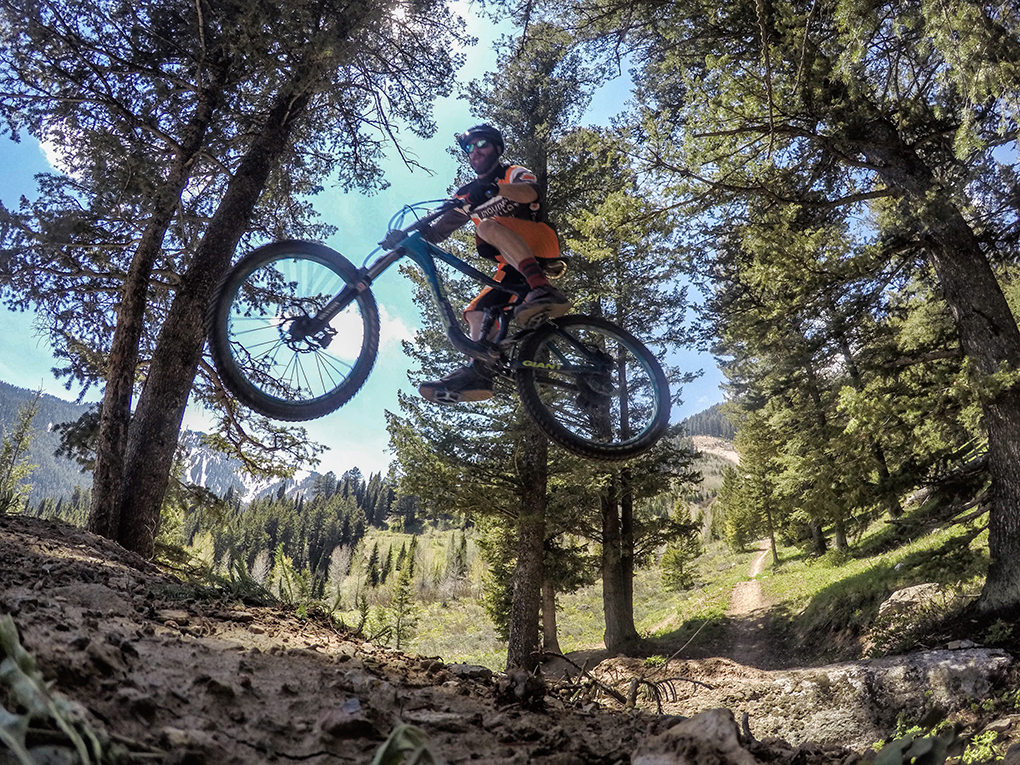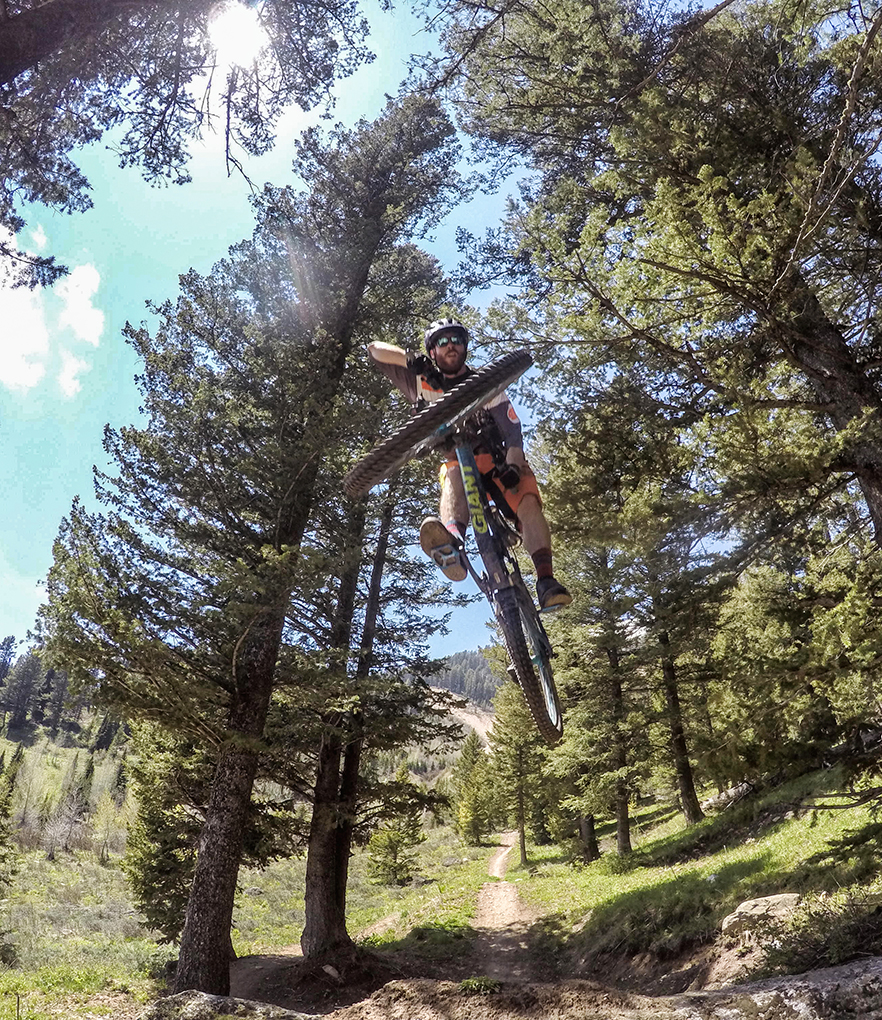
Five Ten Freerider ELC
Size Tested: 10
Stated Features:
- Non-marking Stealth Phantom outsole with classic Dotty™ tread
- PU-coated leather & synthetic upper with lace cover
- Ultra-stiff, one-piece molded cupsole
- Stated weight (Size 9): 494 g each
MSRP: $140
Test Locations: Teton Pass & Teton Canyon, WY; Horseshoe Canyon, ID
Days Tested: 8
Intro
Five Ten’s Freerider line has been a staple among flat-pedal riders, and the Freerider ELC replaces the Freerider Elements we previously reviewed.
Like the Freerider Elements, the Freerider ELC is intended for riders wanting a bit more weather protection than the standard Freerider, but the Freerider ELC takes this a step further with its velcro lace cover (Elements Lace Cover).
And I’ve been blessed with a wet spring in the Tetons to see how effectively the Freerider ELC performs, and how it compares to the Freeride Elements.
Color
The Freerider ELC has such an in-your-face aesthetic that it deserves a comment.

The shoe is available in two colorways: blue & red, and greenish yellow. I’ve been wearing the blue and red version, and while the stock photos of the shoe brought to mind words like “enduro dubstep vomit,” the shoes are much better looking in person. They are nowhere near as flashy as they look on the web.
Fit
On my feet, the Freerider ELC fits identically to the Freerider and Freerider Canvas. That means that while the ELC is by no means a narrow shoe, it is nowhere near as wide as some of the Five Tens of old.
I wear a size 10 in almost all of my shoes, and found that the ELC fit true to size.
Upper
Placed side by side, the Freerider and Freerider ELC bear a striking resemblance. Most of the seams and panels are identical, other than the lace flap.
But the Freerider ELC uses a more technical leather and synthetic upper. It feels a little plastic-y, and does a great job repelling moisture. Water beads up on this material instead of soaking in like it did on the original Freerider.
The “LC”
The lace cover is one of the most important distinctions between the Freerider ELC and the old Freerider Elements. It is easy to use, and it stays securely velcroed down. And it doesn’t just keep the laces from snagging on your drivetrain and trailside brush, it also aids in weatherproofing. While it doesn’t seal the tongue up completely from the elements, it is positioned in such a way that most water on the upper part of the shoe will flow off rather than seep into the cracks around the tongue.
I’ve noticed that it also keeps the laces cleaner which makes tying and adjusting them easier, and should help their longevity. But the lace cover doesn’t really cinch the shoe down at all, so the laces are still responsible for snugging up the shoe around your foot.
Sole
The Freerider ELC uses a fully dot-patterned Stealth PH sole. Five Ten’s soles have a legendary reputation for a reason, and the Freerider is no exception. The Stealth PH sole is not quite as soft and grippy as the Stealth Mi6 rubber found on the Freerider Elements, but I still found it to be more than adequate.
While I don’t yet have enough days in the Freerider ELC to make a definitive statement on the durability of its soles, I have about 40 days in the Freerider Canvas, which has an identical Stealth PH sole.
While those soles have seen some wear around the edges (I sometimes like to drag my toe on the asphalt bike trail out of the bottom of the Teton Pass downhill trails, which accelerates wear), they’ve held up very well, and I expect the Freerider ELC to fare similarly.

The Freerider ELC’s sole is stiffer than the standard Freerider, and combined with the stiffer leather upper and lace flap, it’s instantly noticeable on the trail. My feet stay more comfortable, and I transmit power more efficiently to the pedals in the Freerider ELC.
When hiking, the stiffer sole isn’t quite as comfortable, and the lace flap makes the shoe feel a little stiff compared to my Freerider Canvas. But the upgrade in performance when I’m on the pedals more than makes up for this.
I also appreciate the added protection the stiffer sole gives my toes—the shoe is less likely to deform when smashing into a trailside rock, which is a problem I had when I broke my pinky toe through my Freerider Canvas last year.
Weather Resistance
So, how does all of these features add up when the going gets wet? This spring has seen its fair share of puddle blasting, and I’ve been very impressed. I’ve soaked the Freerider Canvas more times than I can count, and while they dry quickly, riding with swampy feet is no fun.
The Freerider ELC does a very good job keeping my feet dry. For the sake of this review, I stood in a shallow creek for a few minutes with water lapping the bottom of the lace cover. I had no issues with leaks. The upper is more than water-resistant enough for average wet-trail riding, but it is worth remembering that the ELC isn’t a fully waterproof shoe. Deeper wading into the creek very quickly filled them up when the water level reached the tongue junction.
But on the trail, I’ve never wished for more waterproofing. The ELC sheds water very quickly, and does a good job of keeping my feet dry. If, however, you do manage to get a significant amount of water in the shoe, be warned: it doesn’t drain well, and you may need to pull off your socks and squeeze them out.
Breathability
Because of its excellent weatherproofing, the Freerider ELC is not as breathable as the Freerider, or the Freerider Canvas. However I have found that it does breathe adequately well in warmer temps (60+°F) for downhill and most trail riding.
While the ELC wouldn’t be my first choice in the summer months—especially if I lived in a warmer area—it does breathe well enough that I’ll probably continue using it instead of the Freerider Canvas throughout the summer. To me, the stiffer sole and lace flap are worth the slightly warmer feet.
Bottom Line
Five Ten’s Freerider ELC is a strong addition to the Freerider line. It brings another level of weatherproofing, and stiffness while still remaining versatile enough to be a one-shoe-quiver for flat pedal riders.
